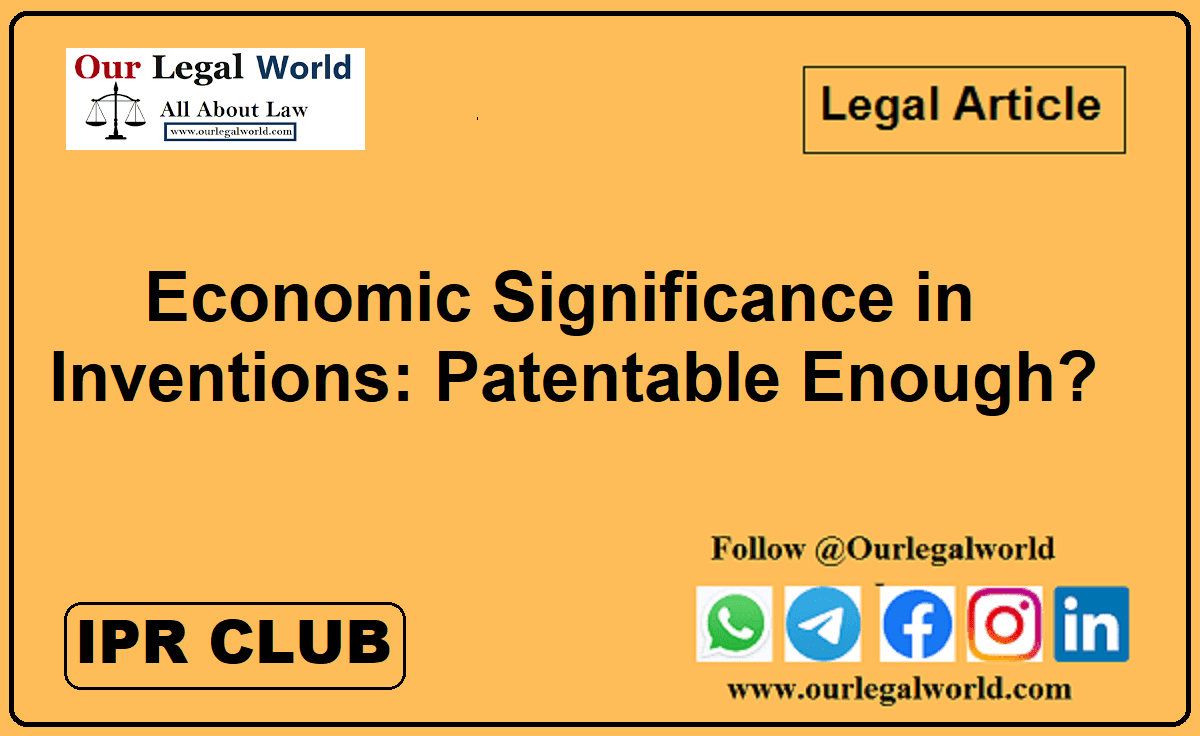Economic Significance in Inventions: Patentable Enough? IPR Club
Written by Rishija Tripathi {KIIT}
Introduction
A patent is the exclusive right given to the owner of an invention for making, selling or using the same for a certain period of time. It is one of the strongest Intellectual Property protection present and provides the patent-holder with an absolute monopoly over the invention. This invention can either be a product or a process.
There are a number of essential requirements that are to be fulfilled if the protection of a patent is to be attracted. These requirements are of novelty, utility, non-obviousness and appropriate subject matter. When any patent application is made, it is first checked upon the grounds of the subject matter for which the Sections 3 and 4 of the Indian Patents Act, 1970 are the set standards to be referred to. This is also referred as to the “Patent-Ability” of an invention. The requirements of novelty, non-obviousness and utility are together referred to as the “Patent-Eligibility” of the invention. In India, the provisions for novelty, non-obviousness and utility can be found from the definition of invention as provided in Section 2(1)(j) of the Patents Act which says that an invention is any new product or process involving an inventive step and capable of industrial application. This definition implies that novelty means nothing but newness of the invention and utility refers to the ability of the invention of being applied or used in industries.
Also Read: Cable Television and Copyright Protection in India
For further clarity on the term non-obvious, it is imperative that we look into the definition of inventive step as provided in Section 2(1)(ja) of the Patents Act. An inventive step is usually in common parlance described as a technical advance which is not obvious to a person skilled in the art. The definition provided under the Patents Act lays down that an inventive step is “a feature of an invention that involves technical advance as compared to the existing knowledge or having economic significance or both and that makes the invention not obvious to a person skilled in the art.” The definition combines the requirement of an invention not being obvious with a feature providing technical advance or economic significance or both.
History of “Invention” & “Inventive Step”
It is important to mention that the definitions of Invention and Inventive Step have not always been the same. For a long time, the term inventive step was not present in the definition of invention and the Patents Act. In fact, it is only in the year 2002 that the definition of invention was amended to add the term inventive step and consequently, the Section 2(1)(ja) defining inventive step was added in the act. The inventive step initially was defined only as a feature which makes the invention non-obvious to a person skilled in the art. This means that by the 2002 amendment, the legislature only intended that there has to be a feature which is not obvious to a person skilled in the art for an invention to have an inventive step.
Later on, in the year 2005 the definition of inventive step provided in Section 2(1)(ja) of the Patents Act was amended to its present form. If the present definition is taken into consideration, it can be concluded that inventive step is only a feature which is not obvious to a person skilled in the art. The amendment of 2005 only does the job of qualifying the term “feature” as
- a “feature” having technical advance or
- a “feature” having economic significance
- or a “feature” having both
along with the ever-present requirement of the said feature being non-obvious to a person skilled in the art. Technical advance in an invention is not the sole criteria for imputing inventive step. Thus, inventive step is a feature which either has technical advance or economic significance or both and because of that technical advance or economic significance or both, the feature becomes non-obvious to a person skilled in the art. This means that a novel invention having a feature reducing the cost of a product significantly, or creating huge demands for the invention in the public and such feature being non-obvious to a person skilled in the art, the invention is as fit for being granted a patent as a novel invention having a feature which provides a technical advance when compared to existing prior art and the said feature being not obvious to a person skilled in the art.
Case Laws Supporting the Interpretation
Therefore, keeping in mind the present discussion, inventive step refers to a feature in an invention which makes the invention not obvious rather than a technical advance which is not obvious to a person skilled in the art. This interpretation of the definition of inventive step as provided under section 2(1)(ja) can be supported by the manner in which the Apex Court has laid down the tests to be satisfied for qualifying as an invention in the case of Novartis A.G Vs. Union of India. In paragraph 90 of the judgement of the said case, the court provides:
“90. On a combined reading of causes (j), (ac) and (ja) of section 2(1), in order to qualify as “invention”, a product must, therefore, satisfy the following tests:
i) It must be “new”;
ii) It must be “capable of being made or used in an industry”
iii) It must come into being as a result of an invention which has a feature that:
a) entails technical advance over existing knowledge;
Or
b) has an economic significance And
c) makes the invention not obvious to a person skilled in the art.”
The test number (iii) provided by the Supreme Court talks about inventive step and has been broken down in the same manner as in the above discussion. Therefore, though the court has not expressly mentioned that the economic significance of a feature can be used to impute inventive step, the third test makes it but obvious that the same can be read in the definition of inventive step.
The most celebrated judgement in India, when it comes to the test of inventive step, M/S Bishwanath Prasad Radhey Shyam v. M/s. Hindustan Metal Industries also gives importance to the economic aspect in an invention. The Supreme Court while giving its decision laid down that for any improvement or combination to be patented has to go through the test of inventive step and to satisfy the same, it should generate a new result or article and a “better or cheaper” article than before.
The change in the definition of inventive step brought about by the 2005 amendment which included the two qualifiers of a non-obvious feature in the definition can also be said to be a result of US jurisprudence related to the non-obviousness requirement in the US patent system. In the case of Graham Vs. John Deere Co., the US Supreme Court mentioned some “secondary considerations” and laid down that these considerations can also be used to signify non-obviousness in an invention. These considerations have been given the name of Graham’s Factors and include:
- Commercial success
- Long felt but unsolved need
- Failure of others
- Unexpected results
The Graham’s Factors can also be cited in support of the interpretation of inventive step as discussed in the blog.
Conclusion
The discussion made in the blog shows that a reference to the definition of inventive step as provided under the Patents Act, 1970 and its correct interpretation will make it clear that the requirement for an inventive step is that of a feature which is not obvious to a person skilled in the art and that feature has been qualified by adding the two phrases “technical advance” and “economic significance”.
Therefore, in cases of lack of technical advance, a non-obvious economic significance in a feature of the invention can also be shown in the invention for it to pass the test of inventive step. This will prove to be a boon for the inventors in cases when there is a situation where they are not able to show ample technical advance and will promote inventions for economic benefits to the society at large.




![Call for Campus Ambassadors by Our Legal World [2 Months; Virtual]: Apply by June 15](https://www.ourlegalworld.com/wp-content/uploads/2024/06/Logo-New-136x150.png)


